The Vienna cemetery where endangered species and biodiversity thrive
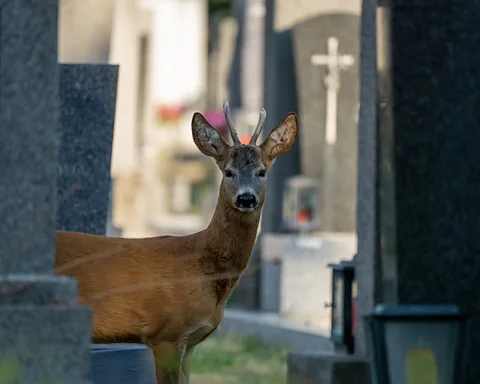 Martina Konecny
Martina KonecnyIn Vienna, Europe's second-largest cemetery has embraced biodiversity – without disturbing the dead.
Some of the greats are here. Beethoven, Schubert, Brahms. As well as the Hollywood pin-up-turned-inventor Hedy Lamarr – oh, and Austrian rock icon Falco. This is their final resting place.
But tread carefully through the Vienna Central Cemetery in the early hours of the morning and you might catch a glimpse of something moving between the weathered headstones. Not ghosts – but puffy-cheeked European hamsters. They're very much alive.
These adorable mammals reside in the Park of Peace and Power on the northern side of the cemetery. Narrow trails on the ground reveal where they have been scurrying lately. Once considered a pest, the hamsters are now critically endangered in Europe. Urbanisation and industrial farming have decimated their habitat in recent decades, and should their population continue to decline, they are likely to be extinct by 2050 according to the IUCN Red List. For now, they're clinging on to life here – in Europe's second-biggest cemetery. As unlikely as it might seem, this place is a perfect home for them. The landscapers are careful not to disrupt their burrows, and visitors like to leave snacks for them. In winter, when their natural food supply runs low, the hamsters often pilfer candles from nearby graves to eat the oil-rich wax.
Urban cemeteries are overlooked biodiversity hubs even though they are similarly valuable to urban parks in terms of species conservation. A 2019 review of graveyard biodiversity identified 140 protected species in cemeteries around the world, from the orchids of Turkish cemeteries to the increasingly scarce steppe vegetation found on burial mounds in Eurasia.
As places of tranquillity with great cultural and spiritual importance to many, cemeteries have largely missed the effects of urbanisation that have taken place in their surrounding cities during recent centuries. As such, they represent refuges for local wildlife and can serve as stepping stone habitats – small patches of nature that animals use to migrate between larger natural areas. This is especially crucial in cities, where green spaces are shrinking and animal habitats are increasingly fragmented.
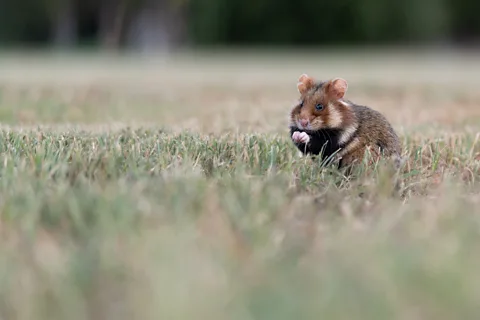 Martina Konecny
Martina KonecnyThe wild inhabitants of the vast Vienna Central Cemetery, which spans 2.4 sq km (0.9 sq miles), are watched over by Thomas Filek, researcher at the University of Natural Resources and Life Sciences in Vienna. Walking across the meadow that has become home to the European hamsters, he points out their small burrows in the tall grass. "We've talked to the gardeners about working in a way that protects biodiversity, and not mowing everything is a big part of it," says Filek. "It's important to think in cycles – it starts with plants, they bring insects, the insects bring birds and so on."
Filek has been documenting local biodiversity with the help of citizen scientists here since 2021 as part of a wider project called Biodiversity in the Cemetery (Biodiversität am Friedhof), which encompasses other graveyards around Austria. The project, based at the University of Natural Resources and Life Sciences in Vienna, receives over 3,000 sighting reports from citizen scientists across different cemeteries every year.
Besides the hamsters, the Vienna Central Cemetery is also home to endangered species protected by the EU Habitats Directive including the European green toad, the Alpine longhorn beetle and the European ground squirrel. The Eurasian hoopoe, which is common in Europe but locally endangered, has also made a home here. In total, Filek and his volunteers have counted more than 240 different animal and plant species here since the project started in 2021.
Cemetery biodiversity is a niche field of study, with researchers often focusing on specific species or sections of a cemetery. This makes cross-country comparisons difficult. A citizen science project comes with its own blind spots, admits Filek: "People tend to notice animals that are big and fly around, less so the small stuff". To counter this, they work with university students who research overlooked areas, like the tiny critters that colonise dead wood, as part of their thesis project.
The cemetery has been famous for its wildlife long before Filek started documenting it, and is a popular haunt for birdwatchers, wildlife photographers and nature lovers. On this windy spring day, the air is filled with birdsong as two playful squirrels chase each other across the graves and into a nearby tree. Lifting some wooden planks that have been purposefully stacked in the grass after a burial, Filek reveals a microcosm of small insects, bugs and snails. No deer, foxes or hares on this visit – they prefer to keep to themselves and often retreat to quieter sections of the cemetery during the day.
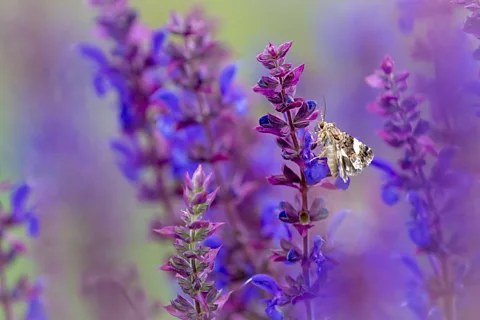 Martina Konecny
Martina KonecnyCemeteries are "a mosaic of different habitats," says Ingo Kowarik, an urban ecologist and retired professor at the Technische Universität Berlin who led one of the first comprehensive surveys of cemetery biodiversity at Berlin's Weißensee Jewish Cemetery in 2016. "This means that species from forests, hedgerows, grasslands and even fields can find substitute habitats there." Man-made features such as mausoleums, tombstones and walls may also support plants and animals that would, in the wild, colonise caves, rocks and cliff faces.
However, such features can also confuse animals – a 2007 study of a Hungarian cemetery found that black gravestones attract dragonflies because their reflective surface resembles water. Poorly planned or maintained cemeteries can also be a source of soil and groundwater pollution, especially in countries where embalming and casket burials are common, while cremation contributes to air pollution.
At the Vienna Central Cemetery, a meadow near the hamster's headquarters is reserved for natural burials, abutting the rows of more traditional graves, covered with stone slabs, ornamental flowers and those delicious candles. Nearby, there are patches of lush forest where final resting places are marked by towering trees and often frequented by deer. "There's an echo of the historical past," says Kowarik, referring to how cemeteries, in general, can preserve wildlife and habitats, even as cities grow up around them.
It was while working as a freshly qualified biology teacher that Filek decided to look more closely at the wildlife in his city. "Very few of us will ever make it to Borneo to see the orangutans," he says. "I wanted to show my students what can be done here."
Initially, however, Filek couldn't find much information about which species were present in the Central Cemetery. That changed thanks to a conversation with Florian Ivanič, a landscape gardener who has worked at the cemetery since 1982. Ivanič led efforts to turn 10 acres (40,000 sq miles) of unused land in the cemetery into a nature garden in 2011. There, plants and animals are left to their own devices as much as possible, with rockeries, ponds and piles of dead wood providing additional microhabitats.
"It was important to me that we have something just for the animals," says Ivanič. "Parks are easy to set up, a landscape architect plans it and then you just mow it. But parks alone are not enough – we need to leave something to nature."
Filek was immediately impressed with Ivanič’s knowledge. "He knows the cemetery like the back of his hand, he really treasures it," Filek says. "I told him I had this idea for a project highlighting cemeteries as biodiversity hotspots, and he was very supportive."
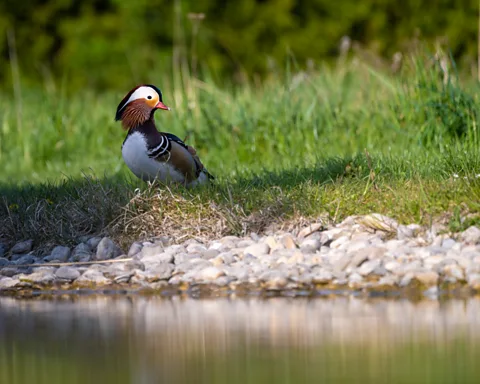 Martina Konecny
Martina KonecnyFilek has worked with the Central Cemetery staff to expand the focus on biodiversity beyond the nature garden. This has involved installing nesting boxes and feeders for birds as well as designating some areas for dead wood and rockeries. Elsewhere, patches of grass are left to grow tall and go to seed. Such measures could be implemented by any cemetery, says Filek. "You can create space for nature behind the graves."
Informational signs dotted around the cemetery explain the importance of different measures and habitats, with photos of the animals that frequent them. The cemetery also offers a guided tour exploring the hamsters' favourite haunts. "People are starting to appreciate that we have something special here," says Filek. "It creates a synergy between cemetery staff, citizens and scientists, who all work together for something worth protecting."
All this effort has begun to pay off. New species such as the locally endangered Eurasian Hoopoe have been sighted in the cemetery since the biodiversity project started. The area's open meadows and old trees reflect the birds' preferred habitat, explains Filek. "By chance, probably also due to changes in the environment, a breeding pair ended up here." Now, five of them are regularly present in the area, and cemetery workers have set up nesting boxes to encourage others to come. Just recently, Filek received the first confirmed sighting of a European Ground Squirrel at the cemetery, a species that is globally endangered and protected under Austrian law.
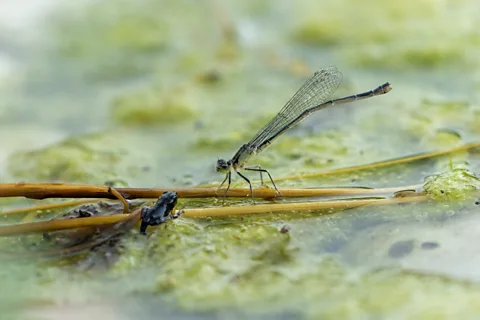 Martina Konecny
Martina KonecnyWhen new graves are dug, the cemetery administration asks Filek for advice, in a bid to minimise disruption to wildlife. For example, only natural burials are allowed near the hamster's burrows, and only in locations where they are not disturbed.
But biodiversity efforts need to be balanced with the visitors' expectations of what a well-cared-for cemetery looks like. "Some people want it to be more manicured, and you have to take that very seriously," says Kowarik. "There's nothing wrong with that at all, because intensively manicured areas are also a piece of this habitat mosaic. The secret of biodiversity in cemeteries is that so many different things are possible."
Plus, at the end of the day, some of these places are still run as businesses – and that can lead to dilemmas. In Berlin, where most of cemeteries are run privately by religious communities or cemetery associations, many are struggling financially because people are opting for urns over casket burials and spending less on burial plots, says Kowarik.
Private cemeteries do not receive funding from the city to maintain their green areas, so they sometimes end up selling their unused land for property development. "We need more green space in cities, not less. Public funds should be used to continue supporting the crucial ecological and social functions of cemeteries," argues Kowarik.
But at the Vienna Central Cemetery, making room for nature is still a priority. "For us, a cemetery is more than just a burial site and a place of remembrance – it's also a refuge for people, animals and plants," says Lisa Pernkopf, spokesperson for Friedhöfe Wien GmbH, which manages Vienna's public cemeteries. "We've realised how important our green spaces are, especially with the aim of doing something for the urban climate and biodiversity."
Filek's hope is that some parts of the cemetery will eventually become protected under nature conservation laws. He has already discussed his idea with city officials. "We have collected the data," he says. "We know what we have here. Now, we have to protect it – and make sure it stays protected."
--
For essential climate news and hopeful developments to your inbox, sign up to the Future Earth newsletter, while The Essential List delivers a handpicked selection of features and insights twice a week.
